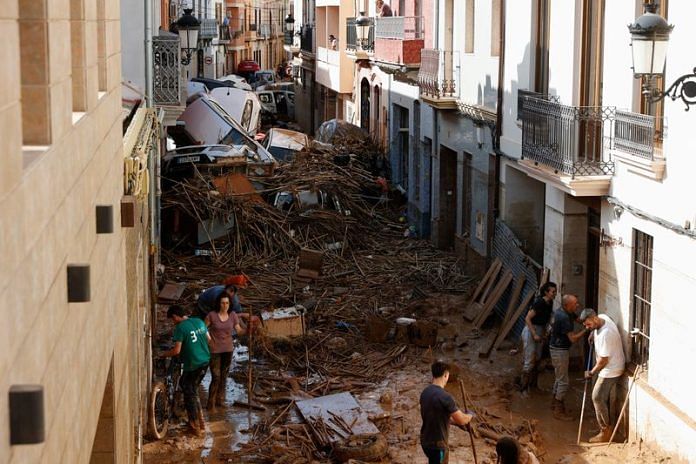By David Latona
VALENCIA/GODELLETA, Spain (Reuters) -The death toll from devastating flash floods in eastern Spain climbed above 155 on Thursday, with rescue teams still searching for those missing in what could become Europe’s worst storm-related disaster in over five decades.
In 2021, at least 185 people died in heavy flooding in Germany. Prior to that, the highest death toll was in Romania in 1970 when 209 died, or further back in 1967 in Portugal when floods killed nearly 500 people.
Local authorities have not disclosed how many people are still unaccounted for, but the tragedy is already Spain’s worst flood-related disaster in modern history, and meteorologists say human-driven climate change is making such extreme weather events more frequent and destructive.
A year’s worth of rain fell in eight hours in parts of the Valencia region on Tuesday. At least 155 people have died in Valencia alone, and another three in two other regions.
Rescue teams on Thursday discovered the bodies of eight people, including a local policeman, who had been trapped in a garage on the outskirts of the city of Valencia, Mayor Maria Jose Catala told reporters.
In the same neighbourhood of La Torre, she said, a 45-year-old woman was also found dead in her home.
“Those people wouldn’t have died if they had been warned in time,” Laura Villaescusa, a neighbour and manager of a local supermarket, told Reuters.
Thousands of people carrying bags or pushing shopping trolleys could be seen on Thursday crossing a pedestrian bridge over the Turia river from La Torre into Valencia city centre to stock up on essential supplies such as toilet paper and water.
Opposition politicians accused the central government in Madrid of acting too slowly to warn residents and send in rescue teams, prompting the Interior Ministry to say regional authorities were responsible for civil protection measures.
Maribel Albalat, mayor of the nearby town of Paiporta, said they had never received warning of the imminent danger of flooding. She said 62 people had died in her town.
“We found a lot of elderly people inside their homes and people who went to get their cars. It was a trap,” she told TVE.
CLINGING TO PILLAR
In Godelleta, a town 37 km (23 miles) west of Valencia city, Antonio Molina, 52, described how he survived a flash flood on Tuesday evening by clinging to a pillar on a neighbour’s porch with water up to his neck till the heavy rain finally subsided.
Molina’s home had already suffered two major floods in 2018 and 2020 and he blamed authorities for allowing construction of residential buildings in depressions where water accumulates.
“We don’t want to live here anymore,” he said, tearfully. “As soon as we get a couple of raindrops, we’re already checking our phones.”
The floods have battered Valencia’s infrastructure, sweeping away bridges, roads and rail tracks and submerging farmland in a region that produces about two-thirds of the citrus fruit grown in Spain, a leading global exporter of oranges.
About 80 km (50 miles) of roads in the eastern region were seriously damaged or impassable, said Transport Minister Oscar Puente. Many were blocked by abandoned cars.
“Unfortunately there are dead bodies in some vehicles,” Puente told reporters, adding that it would take two to three weeks to re-establish the high-speed train connection between Valencia and Madrid.
Visiting a rescue coordination centre near Valencia city, Spanish Prime Minister Pedro Sanchez urged people to stay at home due to the threat of more stormy weather.
“Right now the most important thing is to safeguard as many lives as possible,” he told reporters.
In the hard-hit rural town of Utiel, some 85 km (53 miles) inland, the Magro river burst its banks, sending up to three metres (9.8 feet) of water into the mostly single-storey homes.
Utiel’s mayor, Ricardo Gabaldon, said at least six people had died in the town of about 12,000, most of them elderly or disabled people who were unable to clamber to safety.
Residents used water pumps carried on tractors as they started to clean up on Thursday, with children helping to sweep the sidewalks. Ruined household appliances and furniture were piled up in the middle of roads and elderly people struggled to walk in the slippery, mud-coated streets.
Pope Francis said he was praying for the people of the region. “I’m close to them in this moment of catastrophe,” he said in a video posted on X.
Research group Climate Central said in a report on Thursday that a low-pressure system behind Spain’s floods had tapped into an “atmospheric river” carrying excess moisture from the unusually warm Tropical Atlantic.
According to its Climate Shift Index: Ocean, human-caused climate change has made these elevated sea surface temperatures at least 50 to 300 times more likely.
Hannah Cloke, a professor of hydrology at Britain’s University of Reading, said the Valencia floods showed the need for greater public awareness of the growing dangers.
“We could see that people were putting themselves at risk driving in flood waters and there was just so much water that it has overwhelmed these places,” she said.
(Reporting by David Latona, Emma Pinedo and Inti Landauro; additional reporting by Pietro Lombardi; writing by Charlie Devereux and Andrei Khalip, editing by Helen Popper and Gareth Jones)
Disclaimer: This report is auto generated from the Reuters news service. ThePrint holds no responsibilty for its content.



